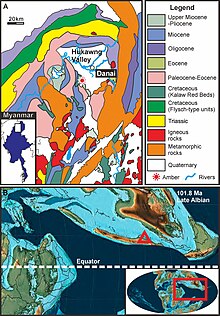
The Burma terrane or West Burma block was an isolated Gondwana-derived island arc within the Tethys Ocean. The terrane was in the upper plate of the subduction zone since early Cretaceous. It collided with Insular India during the Paleocene and continued to be pushed northwards, eventually colliding with mainland Asia. Much of western Myanmar consists of the former Burma Terrane, hence the name "West Burma block".
For a long time it was assumed that it was part of Eurasia since Mesozoic, but more recent geochronology research suggest that it was located near the northwestern Australia margin in the Late Triassic, and paleomagnetic data suggest that the block was at equatorial latitudes on a plate separate from Eurasia from the Cretaceous until the late Eocene.
It is suggested that since the Cretaceous the block was located north of the Andaman Islands in the forearc of the Sunda Trench subduction zone.
Many of the small animals and plants that inhabited the Burma Terrane during the mid-Cretaceous are well-documented due to their exquisite preservation in Burmese amber. Many of these animals were likely endemic to the archipelago due to its isolation at the time, providing a rare comprehensive example of an insular fauna from the Mesozoic. It has been inferred that most of these animals had Gondwanan origins, and that the Burma Terrane may have played an important biogeographic role by serving as a connection by transporting Gondwanan lineages northwards.
See also
- Hațeg Island, another Cretaceous island with a well-documented insular fauna
References
- Westerweel, Jan; Roperch, Pierrick; Licht, Alexis; Dupont-Nivet, Guillaume; Win, Zaw; Poblete, Fernando; Ruffet, Gilles; Swe, Hnin Hnin; Thi, Myat Kai; Aung, Day Wa (October 2019). "Burma Terrane part of the Trans-Tethyan arc during collision with India according to palaeomagnetic data". Nature Geoscience. 12 (10): 863–868. Bibcode:2019NatGe..12..863W. doi:10.1038/s41561-019-0443-2. ISSN 1752-0908. PMC 6774779. PMID 31579400.
- ^ Paleogeography of the West Burma Block and the eastern Neotethys Ocean: Constraints from Cenozoic sediments shed onto the Andaman-Nicobar ophiolites
- Westerweel, Jan; Roperch, Pierrick; Licht, Alexis; Dupont-Nivet, Guillaume; Win, Zaw; Poblete, Fernando; Ruffet, Gilles; Swe, Hnin Hnin; Thi, Myat Kai; Aung, Day Wa (2019). "Burma Terrane part of the Trans-Tethyan arc during collision with India according to palaeomagnetic data". Nature Geoscience. 12 (10): 863–868. Bibcode:2019NatGe..12..863W. doi:10.1038/s41561-019-0443-2. ISSN 1752-0908. PMC 6774779. PMID 31579400.
- Wood, Hannah M; Wunderlich, Jörg (2023-08-01). "Burma Terrane Amber Fauna Shows Connections to Gondwana and Transported Gondwanan Lineages to the Northern Hemisphere (Araneae: Palpimanoidea)". Systematic Biology. 72 (6): 1233–1246. doi:10.1093/sysbio/syad047. ISSN 1063-5157. PMID 37527553.